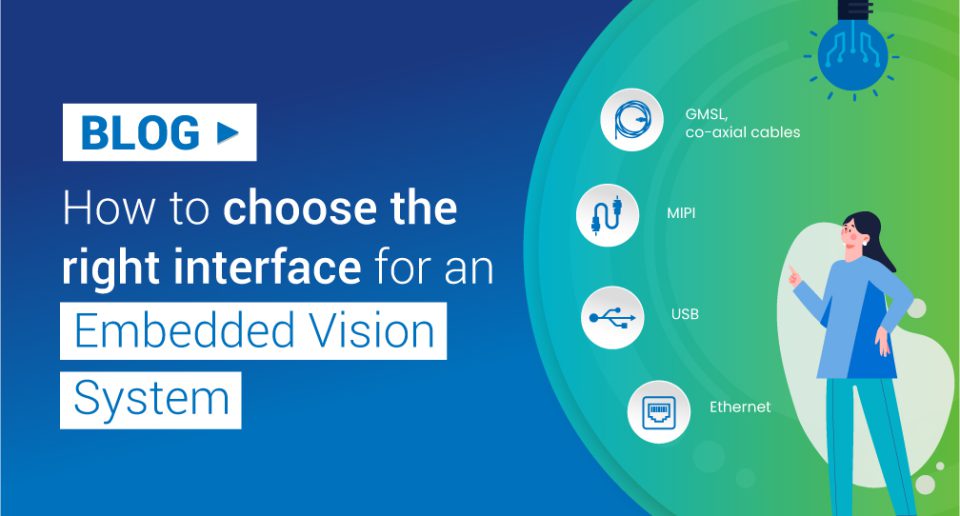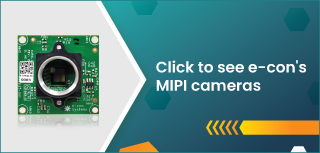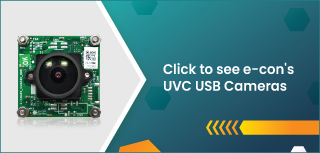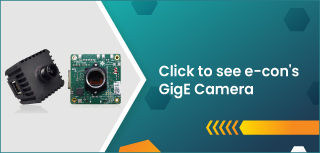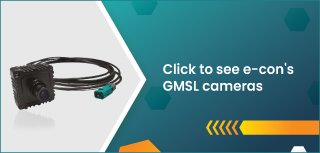Embedded vision systems have brought to life new applications with never-before-seen capabilities. From life sciences and manufacturing and sports broadcasting, they form the backbone of critical functions across many industries – delivering innovation to meet evolving market expectations. The two basic criteria to assess the effectiveness of an embedded vision system are:
- Seamless and high-quality image capturing
- Smooth and quick image processing
When designing an embedded vision system, choosing the right interface is a moment of truth. The interface plays a crucial role in determining its success because it is responsible for transmitting images from the camera to the processing system. Simply put, it is the physical connection layer that connects a camera to the processing platform for image processing. Two defining characteristics include proper throughput and suitable distance. The interface also influences the platform selection process since each one has its own interfacing limitations. In this blog, we hope to equip you to better understand how to choose the right interface for your embedded vision application.
What are the types of interfaces for embedded vision systems?
To meet the growing demand for high-speed connectivity, various flexible and powerful interfaces are available in the market. Some of the most popular interfaces used across several industries are MIPI CSI-2, GMSL2, USB 3.0, and GigE.
MIPI CSI-2
MIPI CSI-2 is one of the most common embedded vision interfaces. Even though it was developed for mobile devices, its 300 MB/s bandwidth makes it ideal for high-performance embedded vision systems. The maximum length of the MIPI CSI-2 cable is under 30cm, which solves application design challenges that involve a higher difference in distance between camera and processing systems. MIPI CSI-2 has four image data lanes that are each capable of 1.5 Gb/s. MIPI CSI-2 is faster than USB 3.0. It’s an efficient and reliable protocol that can handle video from 1080p to 8K and beyond. MIPI CSI-2 also uses fewer resources from the CPU because of multi-core processors. But in some cases, if a driver for the camera is not available, extra development costs can be incurred.
If you are interested in learning more about the MIPI interface and MIPI camera, have a look at the article What is a MIPI camera? How does a MIPI camera work?
USB 3.0
The USB 3.0 interface has a much higher bandwidth than the USB 2.0 interface, up to 360 MB/s. For embedded vision systems, USB 3.0 can be easily integrated with the USB3 Vision Standard. The plug-and-play functionality of USB 3.0 drastically reduces development costs. It also enables embedded vision devices to swap out with ease – making it easy to replace a damaged camera. The USB has large connectors and fairly rigid cabling that may not be ideal for some compact embedded vision components. Most USB embedded vision cameras leverage the USB 3.1 Gen 1 interface to provide up to 5Gibt/s of image data bandwidth between the camera and the host system. USB 3.1 Gen 1 can simplify system design by supplying up to 4.5 W of power to an embedded vision camera.
MIPI and USB are two of the most popular camera interfaces used in embedded vision systems. Have a look at the article MIPI camera vs USB camera – a detailed comparison to learn more about the similarities and differences between the two types of interfaces and cameras.
Gigabit Ethernet (GigE)
The Ethernet interface, which is now mostly implemented as Gigabit-Ethernet (GigE), offers the broadest flexibility in terms of bandwidth, cable length, and multi-camera functionality. This interface can transfer data rates up to 120 mb/s with a maximum cable length of up to 100m and can be integrated into all image processing applications. GigE provides up to 1Gbit/s of image data bandwidth and is available with robust shielding.
GMSL
GMSL is a multigigabit, point-to-point connection that predominantly targets the automotive space. A GMSL interface can carry high-speed video, bidirectional control data, and power over a single coaxial cable. The GMSL cameras can be placed 15 meters away from the host processor through coaxial cable and still support less latency and a high frame rate. GMSL supports multithreading and aggregate protocols like Ethernet and DisplayPort over a single link.
To learn how a GMSL camera compares with a MIPI camera, check out the article GMSL camera over MIPI camera.
How to choose the right interface for an embedded vision system?
The above-mentioned interfaces enable machine vision cameras to connect with host systems by using widely available USB and Ethernet standards. Choosing the right interface doesn’t just depend on the camera, but also target applications and computing platforms. When choosing the right interface for an embedded vision system, you should consider key factors such as bandwidth, cable length, cost, ease of implementation and use, power, and the physical connection required. At the end of the day, it is about choosing the best-fit solution that helps maximize your application’s ROI.
Your decision must be based on what meets your business goals and customer expectations, as much as it does on your existing technology ecosystem. Let’s look at a few ideal interface solutions for popular computing platforms:

MIPI CSI-2, USB, GigE, and GMSL cameras from e-con Systems
Interested in knowing more about how our camera solutions can empower your systems and applications to gain competitive differentiation? Write to our camera solutions experts techsupport@e-consystems.com.




